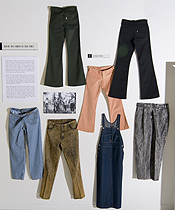|
August 29, 2005
back to efocus
BEN SHAHN GALLERY EXHIBIT FOCUSES ON 150 YEARS OF WOMEN’S COLLEGIATE FASHION
The history of women’s collegiate fashion in the context of a dynamic American culture is the focus of a new exhibit, “Revelation and Revolution: 150 Years of Women’s Collegiate Fashion,” on view in William Paterson University’s Ben Shahn Galleries from September 12 through November 25, 2005. The exhibit, held as part of the University’s celebration of its 150th anniversary during 2005, is open Monday through Friday, 10 a.m. to 5 p.m. Admission is free.
“Clothing often reflects the larger concerns of a society, from economics and politics to social issues,” says Nancy Einreinhofer, director of the University’s Ben Shahn Galleries, who curated the exhibit. She notes that an article in the January 13, 1967 edition of the William Paterson University newspaper, The Beacon, focused on what was then considered a controversial campus issue: wasn’t it time that women be allowed to wear pants to class? “The role of women in society in particular has been reflected in the clothing they wear,” she adds.
Drawing on archival materials dating from the institution’s earliest years as the Paterson Normal School to current photographs, Einreinhofer presents a survey of the evolution of clothing worn by college women.
“It was really a fascinating project,” says Einreinhofer, who read numerous books, pored over hundreds of photographs, and scoured local vintage clothing and antique shops to document the evolution of women’s collegiate fashion, which she outlines in a catalog that accompanies the exhibit. “In 1855, when the University was founded, there were no ready-made clothes and no sewing machines, so a woman’s dresses needed to be made for her. That fact, along with social class, really restricted the number of garments a woman could own. The industrial revolution, and the development of ready-to-wear clothing, especially the boom in manufacturing after World War II, gave women broader choices.”
The exhibit features a variety of materials, including photographs, actual vintage clothing, and other memorabilia such as fashion magazines and sewing patterns to demonstrate how much times have changed on campus. Photographs depict the Paterson Normal School class of 1903, outfitted in long white high-necked Victorian dresses; 1950s co-eds in wide skirts and cardigan sweaters; students dressed in hippie-style jeans and fringed jackets in the 1960s; designer label chic worn by female students in the 1980s; and current students sporting today’s casual and retro styles.
In particular, Einreinhofer says, college women were responsible for the trend of denim as a fashion staple. “The denim revolution is an on-campus phenomenon,” she explains. “In the 1960s, what began as a statement by the era’s flower children became a uniform. Blue jeans became the great equalizer, crossing class lines and the generation gap.” When many colleges still had dress codes and slacks were forbidden for women, as they were for women at William Paterson until 1967, denim was a way to show independence and freedom. Today jeans are ubiquitous on campus, but worn in a variety of styles---bleached, dyed, embroidered, ripped, cuffed, and more.
| |
 |
In conjunction with the exhibit, students in a summer design course taught by Angela DeLaura, associate professor of art, assisted in designing the catalog, including Karen Kozlowski, a senior majoring in art, who created fashion illustrations for each time period, and Daniel Fernandez, who took photos of current students. Also, six students from a fashion design course taught by Nisha Drinkard, an assistant professor of art, created their own contemporary fashion designs, which will be featured on mannequins as part of the exhibit.
“Revelation and Revolution” is one of three shows on view concurrently in the Ben Shahn Galleries. On view in the East Gallery is “The Bride and the Drummer: Artists’ Books from the University Collection,” which features works by contemporary artists who are influenced by Surrealism. The “Annual Art Faculty Exhibit,” featuring recent artworks by William Paterson’s art faculty, is on view in the South Gallery.
This exhibit is made possible in part by funds from the New Jersey State Council on the Arts/Department of State, a partner agency of the National Endowment for the Arts.
The Ben Shahn Galleries are wheelchair-accessible. Large-print handouts are available. For additional information, please call the Ben Shahn Galleries at William Paterson University, 973-720-2654.
Note to editors and reporters: High-resolution, downloadable photographs are available at http://ww2.wpunj.edu/publicityphotos/BenShahnGalleries/CollegiateFashion/
# # #
WILLIAM PATERSON UNIVERSITY 1855-2005: CELEBRATING 150 YEARS
|
|







